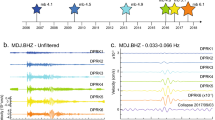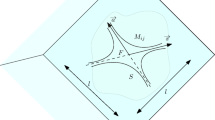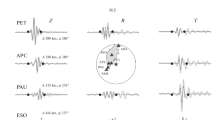Abstract
The design of a monitoring system for detecting explosions is a very topical problem, both for routine data processing at seismological observatories as well as for the monitoring of a Comprehensive Test Ban Treaty. In this framework it is desirable to have the possibility to quantify the presence of the isotropic component in the seismic source. For this purpose a method is presented, which is based on waveform inversion for the full moment tensor retrieval. The method inverts either full waveforms or separate seismic phases and returns the mechanism and time history of a point source. Moreover, it allows to redefine the hypocentral depth of the event and, in a simplistic way, to optimize the structural model as well. In order to model strong laterally heterogeneous structures, different pairs of structural models can be used for each source-receiver path. The source is decomposed into a volumetric part (V), representing an explosive or implosive component, and into a deviatoric part, containing both the double couple (DC) and the compensated linear vector dipole (CLVD) components. The method is applied to an area in central Switzerland and to the network of the Swiss Seismological Service. The events of interest include both earthquakes and explosions. Despite some modelling inadequacies of the source-time function, the explosions can be well identified with the inverted isotropic component in the source, as long as the number of stations used for the inversion is larger than three. The results of the inversion are better for large epicenter-station distances of the order of 40–90 km.
Similar content being viewed by others
References
Baumann, M., 1994, Three-dimensional modelling of the crust-mantle boundary in the Alpine region, PhD thesis No. 10772, Swiss Federal Institute of Technology, Zurich.
Campus, P., Cespuglio, G. and Panza, G. F., 1994, Full moment tensor retrieval and fluid dynamics in volcanic areas: the case of Phlegrean Fields (South Italy), Proc. of the conf. ‘Large explosive eruptions’, Accademia Nazionale dei Lincei, Rome, 1993, pp. 81–101.
Campus, P., Suhadolc, P., Panza, G.F. and Šílený, J., 1996, Complete moment tensor retrieval for weak events: application to orogenic and volcanic areas, Tectonophysics 261, 147–164.
Cespuglio G., Campus P. and Šìlený, J., 1996. Seismic moment tensor resolution by waveform inversion of few local noisy records-II. Application to Phlaegrean Fields (Southern Italy) volcanic tremors, Geophys. J. Int., 126, 620–634.
Deichmann, N. and Baer, M., 1990, Earthquake focal depths below the Alps and northern alpine foreland of Switzerland. In Freeman, R., Giese, P. and Müller, St. (eds), The European Geotraverse: Integrative Studies, European Science Foundation, pp. 277–288.
Deichmann, N., 1992, Structural and rheological implications of lower-crustal earthquakes below northern Switzerland, Physics of the Earth and Planet. Int. 69, 270–280.
Dziewonski, A. M., Chou, T. A. and Woodhouse, J. H., 1981, Determination of earthquake source parameters from wave-form data for studies of global and regional seismicity, J. Geophys. Res. 86, 2825–2852.
Egloff, R., 1979, Sprengseismische Untersuchungen der Erdkruste in der Schweiz, PhD thesis No. 6502, Swiss Federal Institute of Technology, Zurich.
Florsch, N., Fäh. D. Suhadolc, P. and G. F. Panza, 1991, Complete synthetic seismograms for high-frequency multimode SH waves, PAGEOPH 136, 529–560.
Gilbert, F. and Dziewonski, A. M., 1975, An application of normal mode theory to the retrieval of structural parameters and source mechanisms from seismic spectra, Phi. Trans. R. Soc. Lond. A 278, 187–269.
Hanks T. C. and H. Kanamori, 1979, A moment-magnitude scale, J. Geophys. Res. 84, 2348–2350.
Koch, K., 1991, Moment tensor inversion of local earthquake data-I. Investigation of the method and its numerical stability with model calculations, Geophys. J. Int. 106, 305–319.
Langston, C. A., 1981, Source inversion of seismic waveforms: the Koyna, India, Earthquakes of 13 September 1967, Bull. Seism. Soc. Am. 71, 1–24.
Lee, W. H. K. and J. C. Lahr, 1975, HYPO71 (revised): A computer program for determining hypocenter, magnitude, and first motion pattern of local earthquakes, Geol. Surv. Open-File Rep. (U.S.): 75–311.
Maurer, H. and Ansorge, J., 1992, Crustal structure beneath the northern margin of the Swiss Alps, Tectonophysics 207, 165–181.
Nabelek, J. L., 1984, Determination of earthquake source parameters from inversion of body waves, Ph.D. Thesis, Massachusetts Inst. of Technology.
Panza, G. F., 1985, Synthetic seismograms: the Rayleigh waves model summation, J. Geophys. 58, 125–145.
Panza, G. F. and Suhadolc, P., 1987, Complete strong motion synthetics, In Bolt, B. A. (ed.), Seismic Strong Motion Synthetics, Computational Techniques 4, Academic Press, Orlando, pp. 153–204.
Pavoni, N., 1977, Erdbeben im Gebiet der Schweiz, Eclogae, Geol. Helv. 70, 351–370.
Pavoni, N., 1990, Seismicity and fault-plane solutions along the EGT: Data selection and representation as illustrated by the seismicity of Switzerland. In Freeman, R. and Müller, St. (eds), Proc. VI EGT Workshop on Data Compilations and Synoptic Interpretation, European Science Foundation, pp. 341–348.
Šílený J., Panza G. F. and Campus, P., 1992, Waveform inversion for point source moment tensor retrieval with variable hypocentral depth and structural model, Geophys. J. Int. 109, 259–274.
Šílený, J., Campus, P. and Panza, G. F., 1996, Earthquake mechanism resolution by waveform inversion of few local noisy records-I. Synthetic tests in a fixed hypocentre, Geophys. J. Int. 126, 605–619.
Sipkin, S. A., 1982, Estimation of earthquake source parameters by inversion of waveform data: synthetic waveforms, Phys. of the Earth and Planet. Int. 30, 242–259.
Valasek, P., 1992, The tectonic structure of the Swiss alpine crust interpreted from a 2D network of deep crustal seismic profiles and an evaluation of 3D effects, PhD thesis No. 9637, Swiss Federal Institute of Technology, Zurich.
Ye, S., 1992, Crustal structure beneath the central SwissAlps derived from seismic refraction data, PhD thesis No. 9631, Swiss Federal Institute of Technology, Zurich.
Author information
Authors and Affiliations
Rights and permissions
About this article
Cite this article
Campus, P., Fäh, D. Seismic monitoring of explosions: a method to extract information on the isotropic component of the seismic source. Journal of Seismology 1, 205–218 (1997). https://doi.org/10.1023/A:1009781722363
Issue Date:
DOI: https://doi.org/10.1023/A:1009781722363




